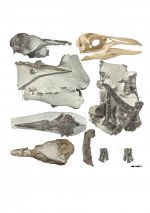Fred Ruhe
Well-known member

Daniel B. Thomas, Alan J. D. Tennyson, R. Paul Scofield, Tracy A. Heath, Walker Pett and Daniel T. Ksepka, 2020
Ancient crested penguin constrains timing of recruitment into seabird hotspot
Proceedings of the Royal Society B: Biological Sciences. 287 (1932): Article ID 20201497. doi:10.1098/rspb.2020.1497
Abstract and free pdf: https://royalsocietypublishing.org/doi/pdf/10.1098/rspb.2020.1497
New Zealand is a globally significant hotspot for seabird diversity, but the sparse fossil record for most seabird lineages has impeded our understanding of how and when this hotspot developed. Here, we describe multiple exceptionally well-preserved specimens of a new species of penguin from tightly dated (3.36–3.06 Ma) Pliocene deposits in New Zealand. Bayesian and parsimony analyses place Eudyptes atatu sp. nov. as the sister species to all extant and recently extinct members of the crested penguin genus Eudyptes. The new species has a markedly more slender upper beak and mandible compared with other Eudyptes penguins. Our combined evidence approach reveals that deep bills evolved in both crested and stiff-tailed penguins (Pygoscelis) during the Pliocene. That deep bills arose so late in the greater than 60 million year evolutionary history of penguins suggests that dietary shifts may have occurred as wind-driven Pliocene upwelling radically restructured southern ocean ecosystems. Ancestral area reconstructions using BioGeoBEARS identify New Zealand as the most likely ancestral area for total-group penguins, crown penguins and crested penguins. Our analyses provide a timeframe for recruitment of crown penguins into the New Zealand avifauna, indicating this process began in the late Neogene and was completed via multiple waves of colonizing lineages.
Enjoy,
Fred
Ancient crested penguin constrains timing of recruitment into seabird hotspot
Proceedings of the Royal Society B: Biological Sciences. 287 (1932): Article ID 20201497. doi:10.1098/rspb.2020.1497
Abstract and free pdf: https://royalsocietypublishing.org/doi/pdf/10.1098/rspb.2020.1497
New Zealand is a globally significant hotspot for seabird diversity, but the sparse fossil record for most seabird lineages has impeded our understanding of how and when this hotspot developed. Here, we describe multiple exceptionally well-preserved specimens of a new species of penguin from tightly dated (3.36–3.06 Ma) Pliocene deposits in New Zealand. Bayesian and parsimony analyses place Eudyptes atatu sp. nov. as the sister species to all extant and recently extinct members of the crested penguin genus Eudyptes. The new species has a markedly more slender upper beak and mandible compared with other Eudyptes penguins. Our combined evidence approach reveals that deep bills evolved in both crested and stiff-tailed penguins (Pygoscelis) during the Pliocene. That deep bills arose so late in the greater than 60 million year evolutionary history of penguins suggests that dietary shifts may have occurred as wind-driven Pliocene upwelling radically restructured southern ocean ecosystems. Ancestral area reconstructions using BioGeoBEARS identify New Zealand as the most likely ancestral area for total-group penguins, crown penguins and crested penguins. Our analyses provide a timeframe for recruitment of crown penguins into the New Zealand avifauna, indicating this process began in the late Neogene and was completed via multiple waves of colonizing lineages.
Enjoy,
Fred




